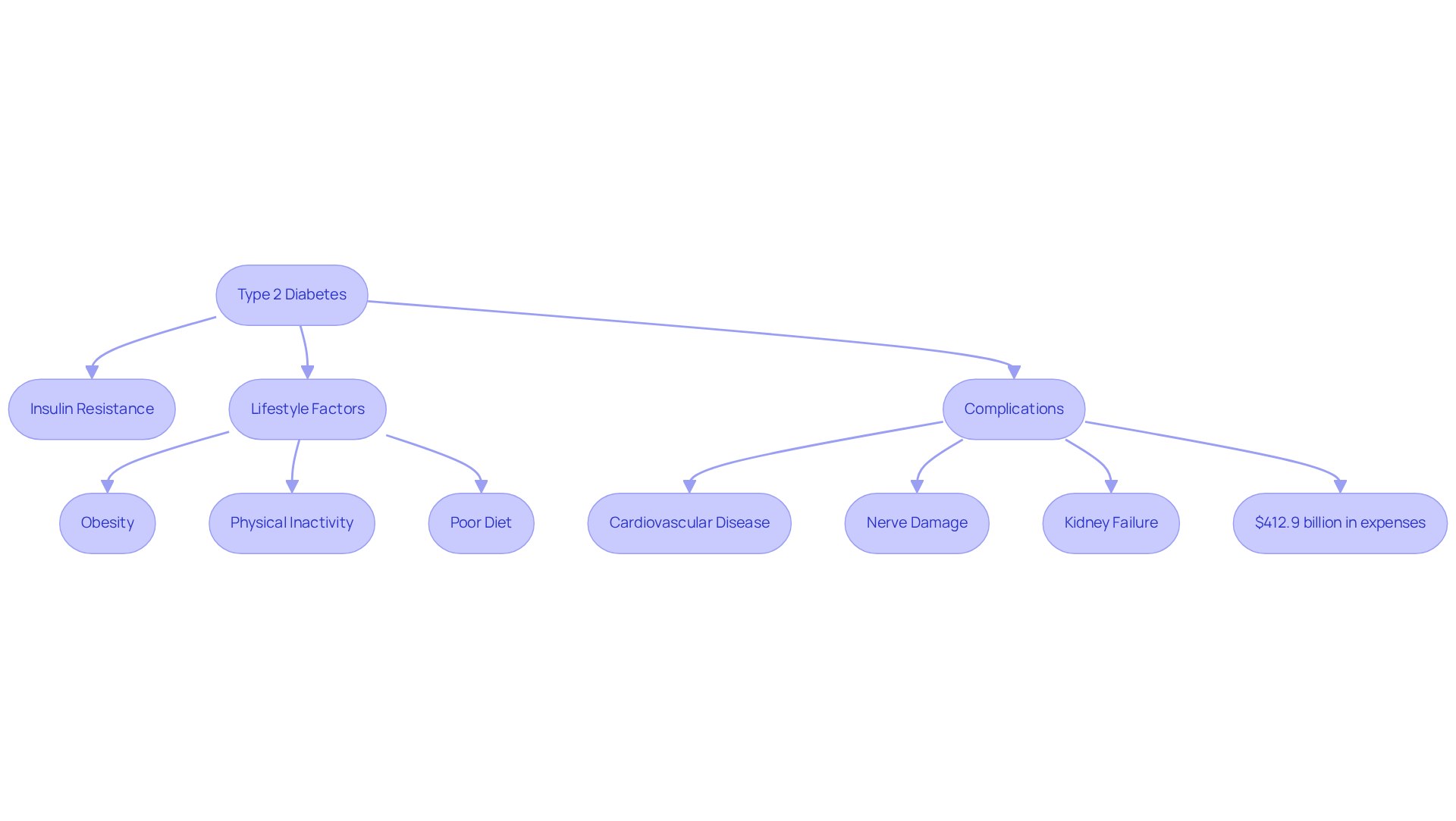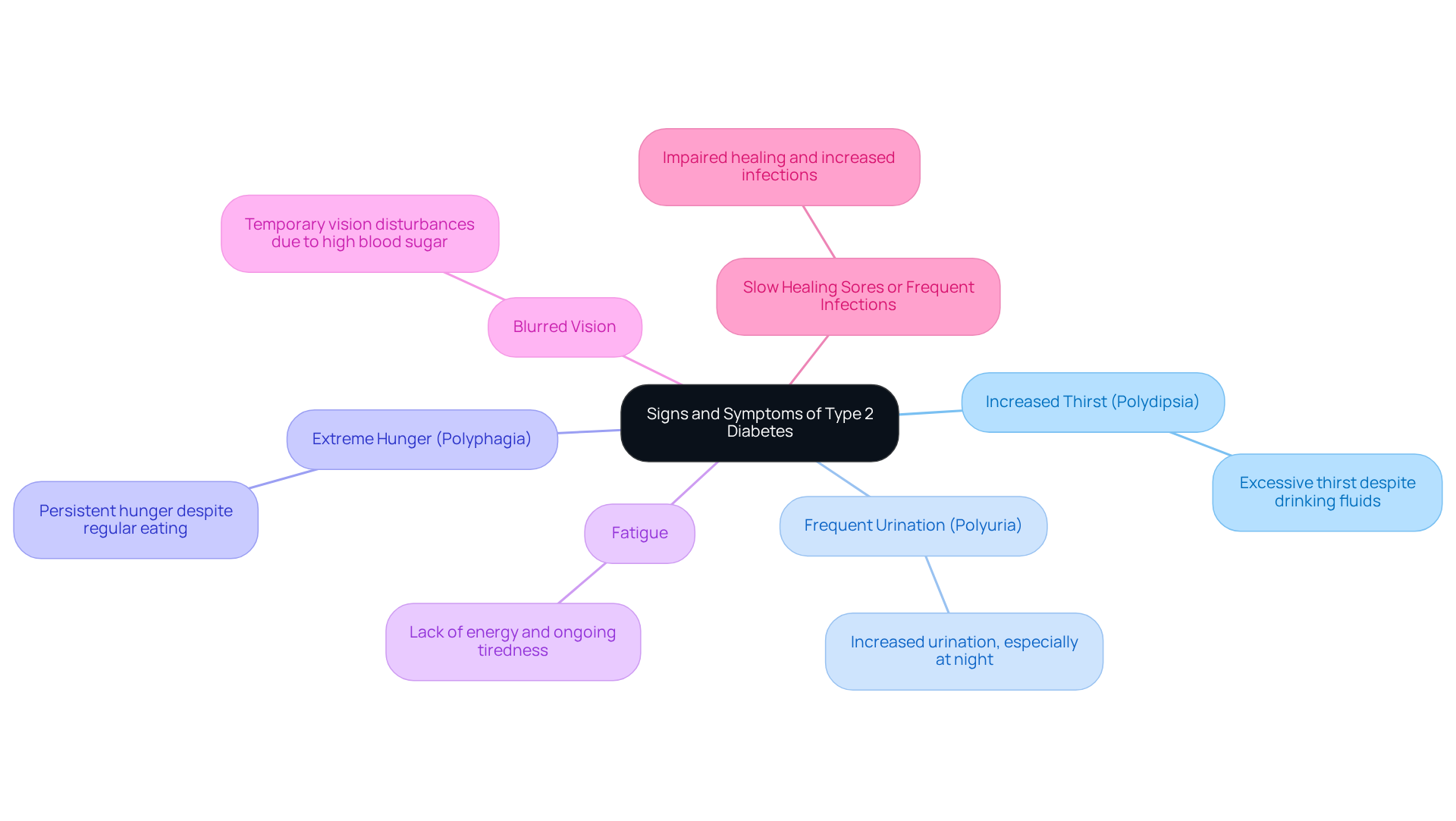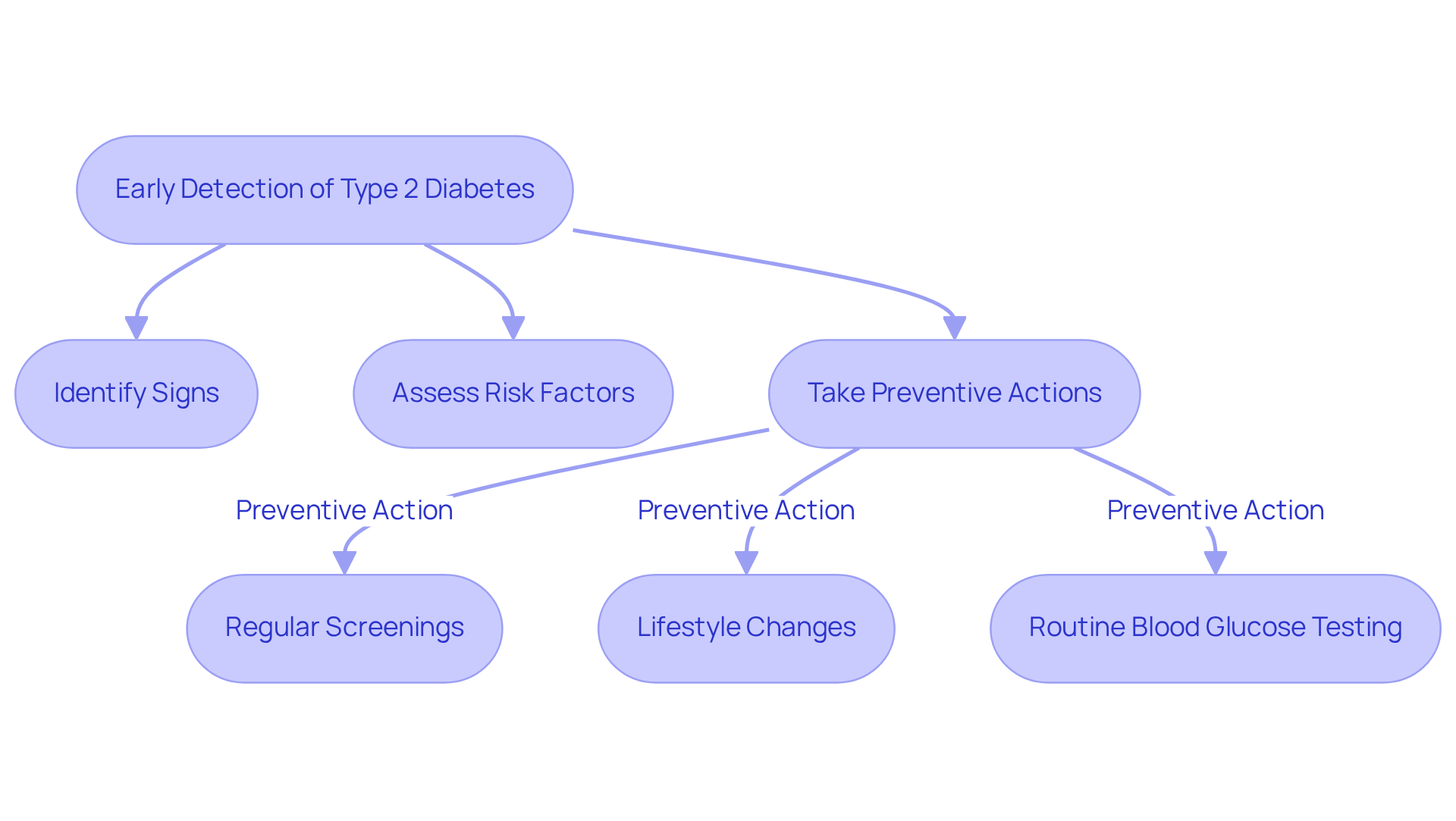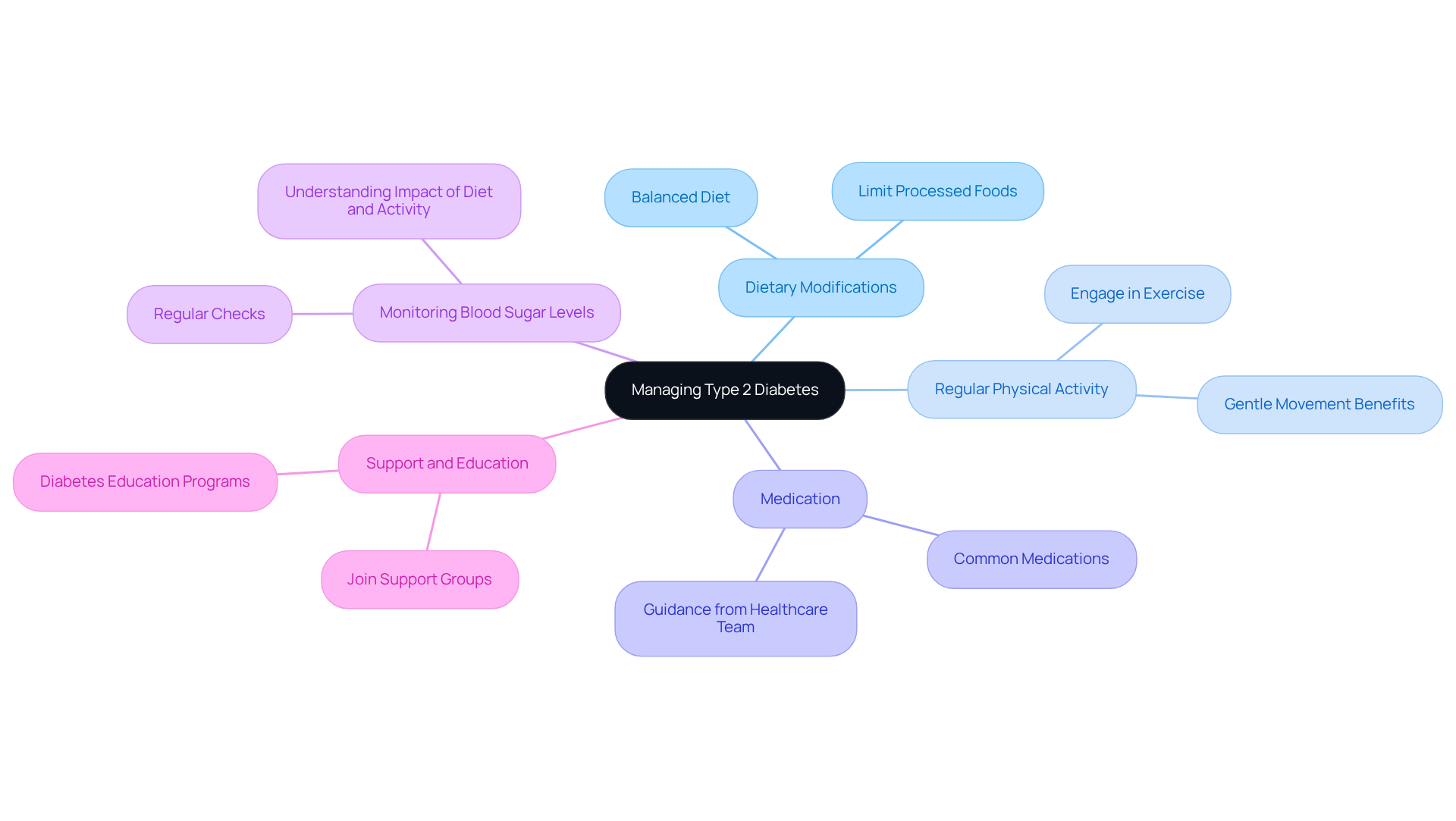Overview
Recognizing the signs of type 2 diabetes, such as increased thirst, frequent urination, and fatigue, is essential for early diagnosis and effective management of your health. It's understandable to feel overwhelmed by these symptoms, but acknowledging them is the first step toward taking control. By recognizing these signs, you can make timely lifestyle changes and seek interventions that significantly reduce the risk of serious health complications associated with unmanaged diabetes.
You’re not alone in this journey. Many individuals have faced similar challenges and found support through community resources and personal connections. Remember, taking action today can lead to a healthier tomorrow. We are here to support you every step of the way.
Introduction
Recognizing the signs of Type 2 Diabetes is not just a health concern; it is a matter of life and death. It's understandable to feel overwhelmed, especially as this condition becomes increasingly prevalent, particularly among younger populations. Understanding its symptoms is crucial for early intervention and management.
This article delves into the subtle yet significant indicators of Type 2 Diabetes, exploring how awareness can empower you to take control of your health before serious complications arise.
What are the key signs that you should be vigilant about? How can recognizing them alter the trajectory of this chronic condition? We are here to support you every step of the way.
Define Type 2 Diabetes
Condition 2 is a persistent metabolic disorder defined by insulin resistance, where the body struggles to utilize insulin effectively, leading to higher blood glucose levels. Unlike Type 1 Diabetes, which is primarily an autoimmune condition, Type 2 Diabetes often develops gradually and is linked to lifestyle factors such as obesity, physical inactivity, and poor diet. It was once called adult-onset diabetes, but due to rising obesity rates, it is increasingly diagnosed in children and adolescents.
Understanding what are the signs of type 2 diabetes is crucial, as failing to manage this condition properly can lead to serious health complications, including:
- Cardiovascular disease
- Nerve damage
- Kidney failure
In 2021, it was the eighth leading cause of death in the United States, underscoring the severity of the condition. The economic impact is significant, with the overall expense of diagnosed diabetes-related conditions in the U.S. reaching $412.9 billion in 2022. Furthermore, around 50% of individuals with this condition face the risk of dying from cardiovascular disease, highlighting the critical health risks associated with unmanaged blood sugar levels. The occurrence of the disease varies across racial and ethnic groups, with 12.1% of non-Hispanic Black adults diagnosed. Additionally, an estimated 8.7 million adults have undiagnosed blood sugar issues, stressing the importance of early detection and awareness.
As T2DSolutions launches as a new resource center for diabetes education and community support, it aims to empower individuals with the knowledge and tools necessary for effective management of this condition. You're not alone in this journey; we encourage you to subscribe to stay updated on the resources and support options available through T2DSolutions. Together, we can navigate this path toward better health.

Identify Signs and Symptoms
At T2DSolutions, we genuinely understand how important it is to know what are the signs of type 2 diabetes for early diagnosis and effective management. These signs can be subtle, often developing gradually, leading to questions about what are the signs of type 2 diabetes that may be easy to overlook. It's crucial to be aware of common symptoms, which include:
- Increased Thirst (Polydipsia): You might find yourself feeling excessively thirsty, even after drinking fluids, as your body works to manage elevated blood sugar levels.
- Frequent Urination (Polyuria): You may notice an increase in urination, especially at night, as your kidneys strive to eliminate excess glucose from your bloodstream.
- Extreme Hunger (Polyphagia): You might feel persistently hungry despite eating regularly due to your body’s struggle to effectively utilize glucose for energy.
- Fatigue: A lack of energy and ongoing tiredness can occur when your body struggles to convert food into usable energy, often leading to feelings of exhaustion.
- Blurred Vision: High blood sugar levels can cause fluid changes in your eyes, leading to temporary vision disturbances, which are among what are the signs of type 2 diabetes.
- Slow Healing Sores or Frequent Infections: Elevated glucose levels may impair your body's natural healing processes and weaken your immune response, making infections more common.
- Unexplained Weight Loss: This occurs when your body begins to break down muscle and fat for energy due to a lack of glucose.
Recognizing what are the signs of type 2 diabetes is vital for early diagnosis and management. Current guidelines recommend regular screening for insulin resistance starting at age 45, or sooner if you have risk factors such as obesity. According to the CDC, about 29.2% of individuals aged 65 and older have Type 2 Diabetes in the United States, highlighting the importance of awareness and proactive health management. As Dr. Kelly Wood notes, "Type 2 mellitus frequently presents no signs in the initial phases, and individuals often discover they have it during a standard lab test." Early detection can significantly reduce the risk of severe complications, including cardiovascular disease and neuropathy. Many individuals learn about their condition during routine blood tests, underscoring the importance of recognizing these signs. By being aware of what are the signs of type 2 diabetes, you can take timely action, potentially preventing the progression of the disease and improving your overall quality of life. For more information on managing diabetes and understanding these symptoms, we encourage you to explore the resources available at T2DSolutions. You're not alone in this journey, and we are here to support you every step of the way.

The Importance of Early Detection
Prompt identification of what are the signs of type 2 diabetes is crucial for effective management and for preventing complications. If diagnosed early, individuals can make significant lifestyle changes, such as improving their diet and increasing physical activity. These changes not only help manage sugar levels but can also potentially reverse the condition. For example, studies indicate that weight loss and regular exercise can reduce the risk of prediabetes progressing to Type 2 Diabetes by up to 71%.
It's understandable to feel overwhelmed by this information, but early intervention can significantly lower the risk of developing severe complications, including heart disease, kidney failure, and neuropathy. Regular screenings and awareness of risk factors—such as family history, obesity, and a sedentary lifestyle—are essential for identifying what are the signs of type 2 diabetes in those at risk. Health professionals recommend routine blood glucose testing, particularly for individuals with risk factors, to detect any abnormalities promptly.
As noted by diabetes specialists, adopting these preventive measures early in life can greatly improve your quality of life and reduce the onset of diabetes-related complications. Remember, you're not alone in this journey; we are here to support you every step of the way. Taking proactive steps today can lead to a healthier tomorrow.

Managing Type 2 Diabetes
Managing Type 2 Diabetes can feel overwhelming, but it’s important to know that you’re not alone in this journey. A multifaceted approach that includes lifestyle changes, medication, and regular monitoring can make a significant difference in your health. Here are some key strategies to consider:
-
Dietary Modifications: Adopting a balanced diet rich in whole grains, fruits, vegetables, and lean proteins while limiting processed foods and sugars can help regulate blood sugar levels. Remember, small changes can lead to big improvements.
-
Regular Physical Activity: Engaging in regular exercise, such as walking, swimming, or cycling, can improve insulin sensitivity and aid in weight management. It’s understandable to feel hesitant about starting a new routine, but even gentle movement can be beneficial.
-
Medication: In certain instances, healthcare providers may prescribe medications to help regulate sugar levels, including metformin or insulin therapy. This is a common step, and your healthcare team is there to guide you.
-
Monitoring Blood Sugar Levels: Regularly checking blood glucose levels allows you to understand how your diet and activity levels affect your condition, enabling timely adjustments. This practice empowers you to take charge of your health.
-
Support and Education: Joining support groups or diabetes education programs can provide valuable resources and encouragement. Connecting with others who share similar experiences can be incredibly uplifting.
By implementing these strategies, you can effectively manage your Type 2 Diabetes and lead a healthier life. Remember, we are here to support you every step of the way.

Conclusion
Recognizing the signs of type 2 diabetes is essential for early intervention and effective management of this prevalent condition. It's understandable to feel overwhelmed, but by understanding the nuances of insulin resistance and its implications on health, you can take proactive steps to mitigate risks and improve your quality of life. The gradual onset of symptoms highlights the importance of vigilance and awareness, ensuring that early detection becomes a priority.
Throughout this article, we discussed key signs such as:
- Increased thirst
- Frequent urination
- Extreme hunger
These symptoms emphasize the need for regular screenings, especially for those at risk. The economic burden and health complications associated with unmanaged diabetes underscore why recognizing these symptoms is crucial. With resources like T2DSolutions available, you can access the support and education necessary to navigate this journey effectively.
Ultimately, the importance of recognizing the signs of type 2 diabetes cannot be overstated. Taking action based on awareness and understanding can lead to significant lifestyle changes that may not only manage but potentially reverse the progression of the disease. Remember, you're not alone in this journey; empowerment through education and community support is vital. Together, we can foster healthier futures and combat the impact of this condition.
Frequently Asked Questions
What is Type 2 Diabetes?
Type 2 Diabetes is a persistent metabolic disorder characterized by insulin resistance, where the body has difficulty utilizing insulin effectively, resulting in higher blood glucose levels. It often develops gradually and is linked to lifestyle factors such as obesity, physical inactivity, and poor diet.
How does Type 2 Diabetes differ from Type 1 Diabetes?
Unlike Type 1 Diabetes, which is primarily an autoimmune condition, Type 2 Diabetes is often related to lifestyle factors and can develop over time. Type 1 is usually diagnosed in childhood, while Type 2 was once known as adult-onset diabetes, but is increasingly diagnosed in children and adolescents due to rising obesity rates.
What are the potential complications of unmanaged Type 2 Diabetes?
Failing to manage Type 2 Diabetes properly can lead to serious health complications, including cardiovascular disease, nerve damage, and kidney failure.
What is the economic impact of Type 2 Diabetes in the United States?
In 2022, the overall expense of diagnosed diabetes-related conditions in the U.S. reached $412.9 billion, highlighting the significant economic burden of the disease.
What are the risks associated with unmanaged blood sugar levels in individuals with Type 2 Diabetes?
Approximately 50% of individuals with Type 2 Diabetes face the risk of dying from cardiovascular disease, underscoring the critical health risks associated with the condition.
How prevalent is Type 2 Diabetes among different racial and ethnic groups?
The occurrence of Type 2 Diabetes varies across racial and ethnic groups, with 12.1% of non-Hispanic Black adults diagnosed with the condition.
How many adults are estimated to have undiagnosed blood sugar issues?
An estimated 8.7 million adults have undiagnosed blood sugar issues, emphasizing the importance of early detection and awareness.
What is T2DSolutions and what does it aim to provide?
T2DSolutions is a new resource center for diabetes education and community support, aimed at empowering individuals with knowledge and tools necessary for effective management of Type 2 Diabetes.
How can individuals stay updated on resources and support for Type 2 Diabetes?
Individuals are encouraged to subscribe to T2DSolutions to stay informed about available resources and support options for managing Type 2 Diabetes.



